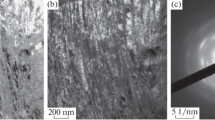Abstract
A functionally graded NiTi shape memory alloy wire was investigated by in situ synchrotron radiation-based X-ray diffraction (SR-XRD) during cyclic tensile deformation. The transformation temperatures were determined by DSC and the thermomechanical behaviour was analysed by three-point bending test. The present study focussed on the localized heat treatment (Joule heat effect, reaching 300 °C, 350 and 400 °C pulses for 10 min) of NiTi wires, using an equipment that allows a large variety of graded conditions. Structural, mechanical and thermomechanical characterization is presented to get a perspective of the different types of graded functionality. A combination of two strategies has been used for the in situ analysis by SR-XRD of the tensile tests: (i) continuously following the structural evolution at one single point (at the center of the heat-treated segment) all long the load/unload cycle and (ii) scanning the full heat-treated segmentat previously defined discrete steps of the stress–strain curve. The combined information from both types of tests provided detailed information about the phase transformations taking place in different regions of the functionally graded segment, at different steps of the tensile load/unload cycle, giving a better understanding of the overall mechanical, namely the evidence of the sequence B2 ↔ R ↔ B19′ for the direct and reverse transformations.









Similar content being viewed by others
References
Otsuka K, Ren X (2005) Physical metallurgy of Ti–Ni-based shape memory alloys. Prog Mater Sci 50:511–678
Shariat BS, Meng Q, Mahmud AS, Wu Z, Bakhtiari R, Zhang J, Motazedian F, Yang H, Rio G, Nam T, Liu Y (2017) Functionally graded shape memory alloys: design, fabrication and experimental evaluation. Mater Des 124:225–237
Bataillard L, Bidaux J-E, Gotthardt R (1998) Interaction between microstructure and multiple-step transformation in binary NiTi alloys using in-situ transmission electron microscopy observations. Philos Mag A 78:327–344
Shariat BS, Liu Y, Rio G (2013) Modelling and experimental investigation of geometrically graded NiTi shape memory alloys. Smart Mater Struct 22:025030
Shariat BS, Liu Y, Rio G (2012) Thermomechanical modelling of microstructurally graded shape memory alloys. J Alloys Compd 541:407–414
Martins RMS, Schell N, Gordo PR, Maneira MJP, Silva RJC, Braz Fernandes FM (2009) Development of sputtered shape memory alloy (SMA) Ni–Ti films for actuation in ice cooled environments. Vacuum 83:1299–1302
Meng Q, Wu Z, Bakhtiari R, Zhang J, Yang H, Liu Y (2016) Stress serration and arch-shaped Lüders stress plateau behaviour of Ti–50.8at% Ni wire prepared by selective electrical resistance over-aging. Smart Mater Struct 25:115035
Oliveira JP, Braz Fernandes FM, Miranda RM, Schell N, Ocaña JL (2016) Effect of laser welding parameters on the austenite and martensite phase fractions of NiTi. Mater Charact 119:148–151
Šittner P, Lukáš P, Novák V, Daymond MR, Swallow GM (2004) In situ neutron diffraction studies of martensitic transformations in NiTi polycrystals under tension and compression stress. Mater Sci Eng A 378:97–104
Young ML, Wagner MF-X, Frenzel J, Schmahl WW, Eggeler G (2010) Phase volume fractions and strain measurements in an ultrafine-grained NiTi shape-memory alloy during tensile loading. Acta Mater 58:2344–2354
Jones NG, Dye D (2011) Martensite evolution in a NiTi shape memory alloy when thermal cycling under an applied load. Intermetallics 19:1348–1358
Héraud L, Castany P, Lailllé D, Gloriant T (2015) In situ synchrotron X-ray diffraction of the martensitic transformation in superelastic Ti-27Nb and NiTi alloys: a comparative study. Mater Today: Proc 2S:S917–S920
Sedmák P, Pilch J, Heller L, Kopeček J, Wright J, Sedlák P, Frost M, Šittner P (2016) Grain-resolved analysis of localized deformation in nickel-titanium wire under tensile load. Science 353:559–562
Benafan O, Garg A, Noebe RD, Skorpenske HD, An K, Schell N (2017) Deformation characteristics of the intermetallic alloy 60NiTi. Intermetallics 82:40–52
Hsu WN, Polatidis E, Smíd M, Casati N, Van Petegem S, Van Swygenhoven H (2018) Load path change on superelastic NiTi alloys: in situ synchrotron XRD and SEM DIC. Acta Mater 144:874–883
Huang X, Liu Y (2001) Effect of annealing on the transformation behaviour and superelasticity of NiTi shape memory alloy. Scr Mater 45:153–160
Sittner P, Sedlak P, Landa M, Novak V, Lukas P (2006) In situ experimental evidence on R-phase related deformation processes in activated NiTi wires. Mater Sci Eng A 438–440:579–584
Héraud L, Castany P, Lailllé D, Gloriant T (2015) In situ synchrotron X-ray diffraction of the martensitic transformation in superelastic Ti-27Nb and NiTi alloys: a comparative study International Conference on Martensitic Transformations, ICOMAT-2014. Mater Today: Proc 2S:S917–S920
Acknowledgements
Authors gratefully acknowledge the funding of Project POCI-01-0145-FEDER-016414 (FIBR3D), cofinanced by Programa Operacional Competitividade e Internacionalização and Programa Operacional Regional de Lisboa, through Fundo Europeu de Desenvolvimento Regional (FEDER) and by National Funds through FCT - Fundação para a Ciência e a Tecnologia. P.F.R., EC and F.M.B.F acknowledge the funding of CENIMAT/I3N by National Funds through FCT - Portuguese Foundation for Science and Technology, Reference UID/CTM/50025/2019 and FCT/MCTES. P.F.R. acknowledges the funding of CAPES (CsF/ Brazil—BEX 11943-13-0). TS and PI acknowledge Fundação para a Ciência e a Tecnologia (FCT - MCTES) for its financial support of UNIDEMI via the project UID/EMS/00667/2019. Parts of this research were carried out at beamline P-07-HEMS at DESY, a member of the Helmholtz Association. The research leading to this result has been supported by the project CALIPSOplus under the Grant Agreement 730872 from the EU Framework Programme for Research and Innovation HORIZON 2020.
Author information
Authors and Affiliations
Corresponding author
Additional information
Publisher's Note
Springer Nature remains neutral with regard to jurisdictional claims in published maps and institutional affiliations.
Rights and permissions
About this article
Cite this article
Braz Fernandes, F.M., Camacho, E., Rodrigues, P.F. et al. In Situ Structural Characterization of Functionally Graded Ni–Ti Shape Memory Alloy During Tensile Loading. Shap. Mem. Superelasticity 5, 457–467 (2019). https://doi.org/10.1007/s40830-019-00237-2
Received:
Revised:
Accepted:
Published:
Issue Date:
DOI: https://doi.org/10.1007/s40830-019-00237-2




